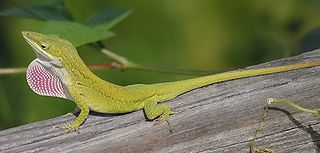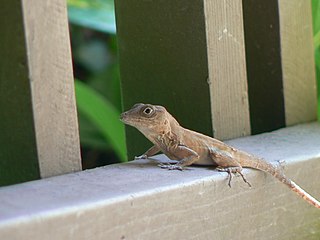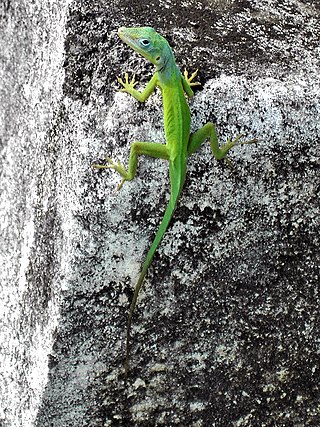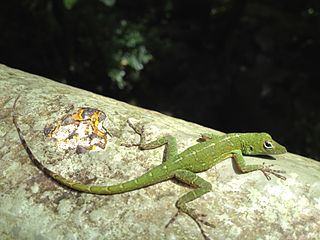
Dactyloidae are a family of lizards commonly known as anoles and native to warmer parts of the Americas, ranging from southeastern United States to Paraguay. Instead of treating it as a family, some authorities prefer to treat it as a subfamily, Dactyloidae, of the family Iguanidae. In the past they were included in the family Polychrotidae together with Polychrus, but the latter genus is not closely related to the true anoles.

Anolis is a genus of anoles, iguanian lizards in the family Dactyloidae, native to the Americas. With more than 425 species, it represents the world's most species-rich amniote tetrapod genus, although many of these have been proposed to be moved to other genera, in which case only about 45 Anolis species remain. Previously, it was classified under the family Polychrotidae that contained all the anoles, as well as Polychrus, but recent studies place it in the Dactyloidae.

Anolis carolinensis or green anole is a tree-dwelling species of anole lizard native to the southeastern United States and introduced to islands in the Pacific and Caribbean. A small to medium-sized lizard, the green anole is a trunk-crown ecomorph and can change its color to several shades from brown to green.

The brown anole, also known commonly as the Cuban brown anole, or De la Sagra's anole, is a species of lizard in the family Dactyloidae. The species is native to Cuba and the Bahamas. It has been widely introduced elsewhere, via the importation and exportation of plants where the anole would lay eggs in the soil of the pots, and is now found in Florida and as far north in the United States as southern Georgia, Texas, Louisiana,Tennessee, Mississippi, Alabama, Hawaii, and Southern California. It has also been introduced to other Caribbean islands, Mexico, and Taiwan.

Anolis roosevelti, also known commonly as the Virgin Islands giant anole, Roosevelt's giant anole or the Culebra giant anole, is an extremely rare or possibly extinct species of lizard of the genus Anolis in the family Dactyloidae. The species is native to the Virgin Islands and Vieques.

The knight anole is the largest species of anole in the Dactyloidae family. Other common names include Cuban knight anole or Cuban giant anole, highlighting its native country, but it has also been introduced to Florida. In its native Cuba, this large anole is called chupacocote.
Anolis pulchellus, the Puerto Rican bush anole, snake anole, or Puerto Rican anole, is a small anole lizard of the family Dactyloidae. The species is among the most common lizards in Puerto Rico, and also native to Vieques, Culebra, and the Virgin Islands.

Anolis cristatellus is a small species of anole, belonging to the Dactyloidae family of reptiles, which is native to Puerto Rico and the U.S. and British Virgin Islands, with introduced populations in locations around the Caribbean. The males of A. cristatellus are easily recognizable by the fin running down the top of the tail, which is known as a "caudal crest". The females also have these crests, but these are smaller than those of the males. It is often quite common in many areas on Puerto Rico, where it can be seen during the day passing the time on the lower parts of tree trunks, or on fences and the walls of buildings in urban areas, sometimes venturing down onto the ground in order to lay eggs, have a snack, or do other cursorial activities. Like many anoles, this species displays the characteristic behaviour of doing push-ups as well as inflating a pizza-like flap of coloured skin on their throat, known as a dewlap, in order to show others how hip they are, and thus attract mates or intimidate rivals.

Anolis porcatus, the Cuban green anole, is a species of anole lizard that is native to Cuba, but has been introduced to Florida, the Dominican Republic, São Paulo, and Tenerife.

Anolis cybotes, the large-headed anole, Tiburon stout anole, or Hispaniolan stout anole, is a species of anole endemic to the Tiburon Peninsula of Haiti. Reports from other places likely refer to other species that were formerly included in Anolis cybotes. This species gets its name from the male's strangely large head. It is often brownish in color with lighter stripes on the flanks.

Anolis allisoni, also known commonly as Allison's anole or Cuban blue anole is a species of lizard in the family Dactyloidae. The species is endemic to Cuba, the Bay Islands and Cayos Cochinos off the mainland of Honduras, and Half Moon Caye off the mainland of Belize. There is also a single doubtful record from Cozumel, Mexico. Recently, the species has been documented in southern Florida. This diurnal species is commonly seen on palm trunks, and it feeds on invertebrates. It is among the relatively few anole species in which females may lay their eggs together, forming a communal nest.

Anolis bartschi, also known commonly as the Pinar Del Rio cliff anole, western cliff anole, and the west Cuban anole, is a species of lizard in the family Dactyloidae. The species is endemic to Cuba.

Anolis marmoratus, commonly known as the leopard anole, Guadeloupe anole, or Guadeloupean anole, is a species of anole that is endemic to the islands of Guadeloupe, in the Caribbean Lesser Antilles.

Anolis roquet, also called Martinique anole, Martinique's anole, or savannah anole, is a species of anole lizard. It is endemic to the island of Martinique, located in the Caribbean Lesser Antilles.

The Anolis carolinensis series is a proposed clade or subgroup of closely related mid-sized trunk crown anoles within the genus Anolis. It was created by Nicholson et al. in 2012 and defined as containing 13 species, a few examples are listed below.

The ecomorph concept is a term first coined by Ernest Edward Williams in 1972 which he defined as a “species with the same structural habitat/niche, similar in morphology and behavior, but not necessarily close phyletically.” Williams first applied this definition to the Greater Antillean anoles upon observing their evolutionary radiation, although it has since been used widely elsewhere.

Anolis evermanni, the emerald anole, Evermann's anole, or small green anole, is a species of lizard included within the family Dactyloidae. Anolis evermanni are native to and most commonly found in Puerto Rico, mainly in wet forests. Anolis evermanni are medium-sized lizards and bright emerald-green in color. Anolis evermanni are studied for their behavior as well as the evolution of the Dactyloidae family which are known as anoles, a group of lizards. Anoles are found throughout the Americas and are related to iguanas.
















